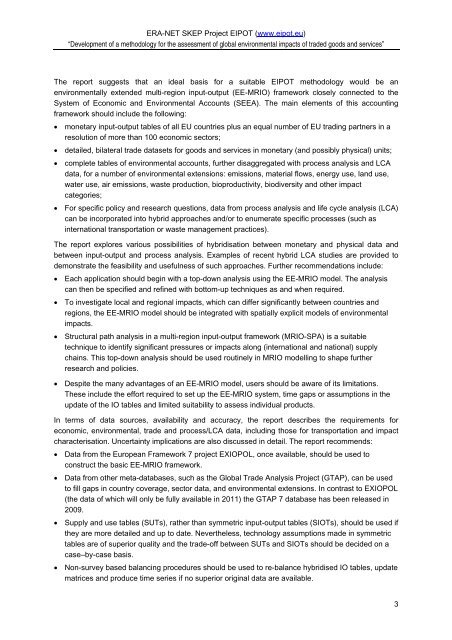EIPOT Final Project Report - Stockholm Environment Institute
EIPOT Final Project Report - Stockholm Environment Institute
EIPOT Final Project Report - Stockholm Environment Institute
You also want an ePaper? Increase the reach of your titles
YUMPU automatically turns print PDFs into web optimized ePapers that Google loves.
ERA-NET SKEP <strong>Project</strong> <strong>EIPOT</strong> (www.eipot.eu)<br />
“Development of a methodology for the assessment of global environmental impacts of traded goods and services”<br />
The report suggests that an ideal basis for a suitable <strong>EIPOT</strong> methodology would be an<br />
environmentally extended multi-region input-output (EE-MRIO) framework closely connected to the<br />
System of Economic and <strong>Environment</strong>al Accounts (SEEA). The main elements of this accounting<br />
framework should include the following:<br />
• monetary input-output tables of all EU countries plus an equal number of EU trading partners in a<br />
resolution of more than 100 economic sectors;<br />
• detailed, bilateral trade datasets for goods and services in monetary (and possibly physical) units;<br />
• complete tables of environmental accounts, further disaggregated with process analysis and LCA<br />
data, for a number of environmental extensions: emissions, material flows, energy use, land use,<br />
water use, air emissions, waste production, bioproductivity, biodiversity and other impact<br />
categories;<br />
• For specific policy and research questions, data from process analysis and life cycle analysis (LCA)<br />
can be incorporated into hybrid approaches and/or to enumerate specific processes (such as<br />
international transportation or waste management practices).<br />
The report explores various possibilities of hybridisation between monetary and physical data and<br />
between input-output and process analysis. Examples of recent hybrid LCA studies are provided to<br />
demonstrate the feasibility and usefulness of such approaches. Further recommendations include:<br />
• Each application should begin with a top-down analysis using the EE-MRIO model. The analysis<br />
can then be specified and refined with bottom-up techniques as and when required.<br />
• To investigate local and regional impacts, which can differ significantly between countries and<br />
regions, the EE-MRIO model should be integrated with spatially explicit models of environmental<br />
impacts.<br />
• Structural path analysis in a multi-region input-output framework (MRIO-SPA) is a suitable<br />
technique to identify significant pressures or impacts along (international and national) supply<br />
chains. This top-down analysis should be used routinely in MRIO modelling to shape further<br />
research and policies.<br />
• Despite the many advantages of an EE-MRIO model, users should be aware of its limitations.<br />
These include the effort required to set up the EE-MRIO system, time gaps or assumptions in the<br />
update of the IO tables and limited suitability to assess individual products.<br />
In terms of data sources, availability and accuracy, the report describes the requirements for<br />
economic, environmental, trade and process/LCA data, including those for transportation and impact<br />
characterisation. Uncertainty implications are also discussed in detail. The report recommends:<br />
• Data from the European Framework 7 project EXIOPOL, once available, should be used to<br />
construct the basic EE-MRIO framework.<br />
• Data from other meta-databases, such as the Global Trade Analysis <strong>Project</strong> (GTAP), can be used<br />
to fill gaps in country coverage, sector data, and environmental extensions. In contrast to EXIOPOL<br />
(the data of which will only be fully available in 2011) the GTAP 7 database has been released in<br />
2009.<br />
• Supply and use tables (SUTs), rather than symmetric input-output tables (SIOTs), should be used if<br />
they are more detailed and up to date. Nevertheless, technology assumptions made in symmetric<br />
tables are of superior quality and the trade-off between SUTs and SIOTs should be decided on a<br />
case–by-case basis.<br />
• Non-survey based balancing procedures should be used to re-balance hybridised IO tables, update<br />
matrices and produce time series if no superior original data are available.<br />
3
















